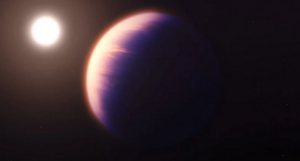Nasa’s James Webb Space Telescope has detected carbon dioxide on an alien world, for the first time.
A team of more than 30 scientists analyzing the spectrum of the gas giant exoplanet Wasp 39b have reported finding a clear signal of an abundance of carbon dioxide in the planets atmosphere. Previous studies by the Hubble and Spitzer Space Telescopes had detected water vapor, potassium and sodium in the exoplanet’s atmosphere, but this is the first time carbon dioxide — a green house gas and, at least on Earth, a product of animal metabolism — has been clearly identified on distant world.
The new findings have been accepted for publication in the journal Nature and are currently available on the online academic server Arxiv.
US Grand Strategy should include Cyprus – Opinion
The result is one of the first findings to come from Webb’s first observations, and suggests the new space telescope may also help tease apart the atmospheric components of smaller, rocky, Earth-like exoplanets during its operational life time. Accurate detection of gas concentrations in the atmospheres of such planets could help scientists detect signs of alien life, if it exists.
Read more: yahoo
Ask me anything
Explore related questions





